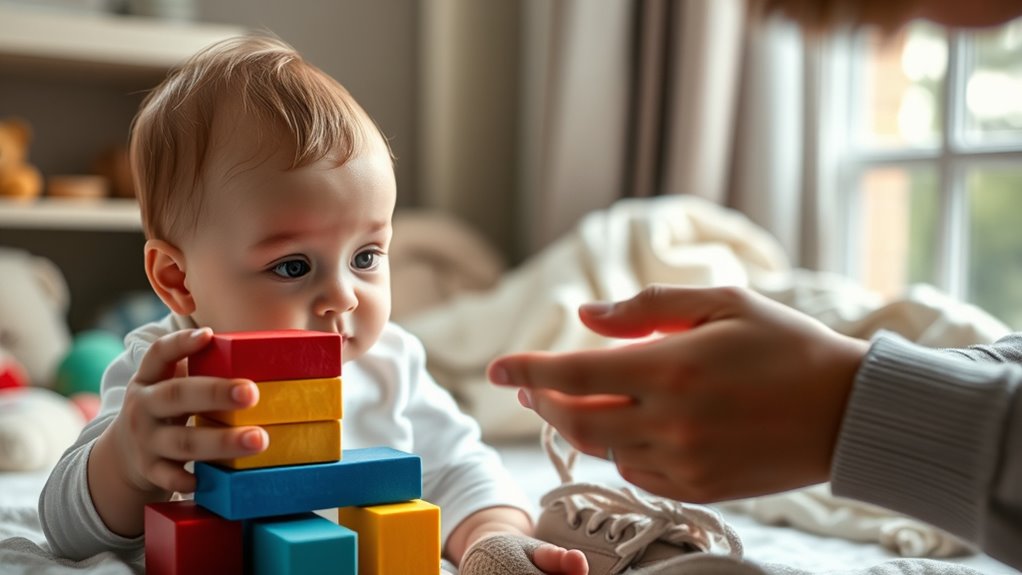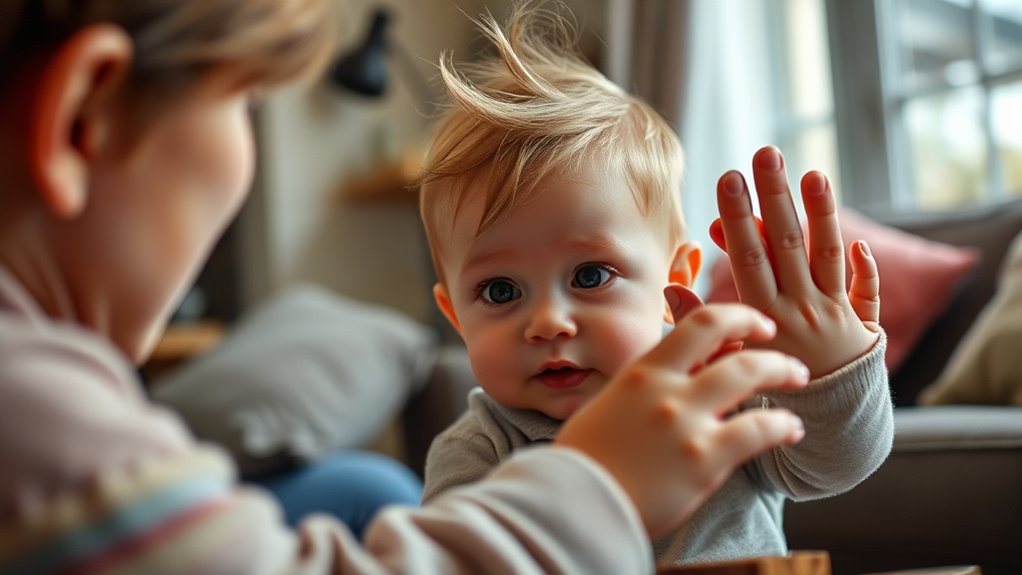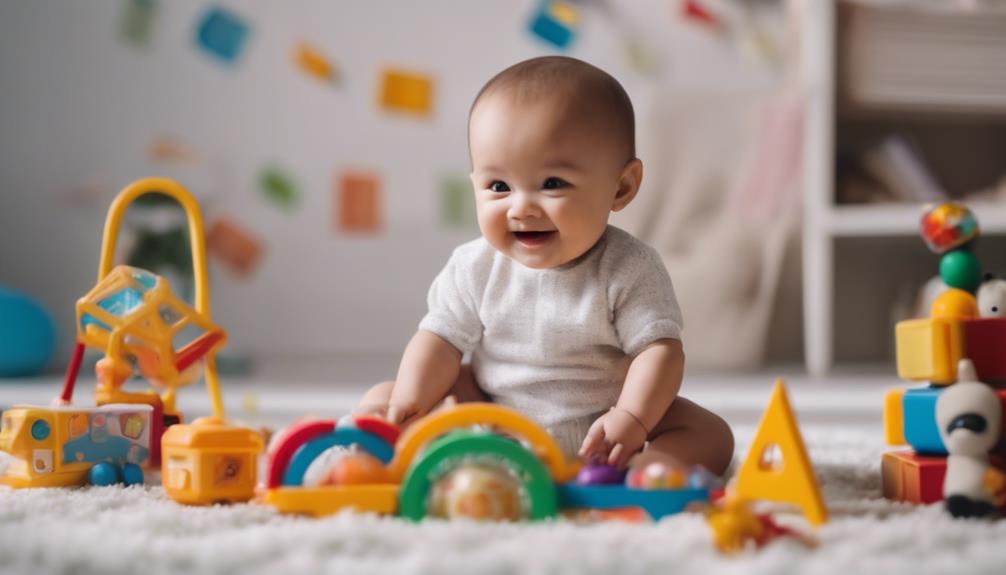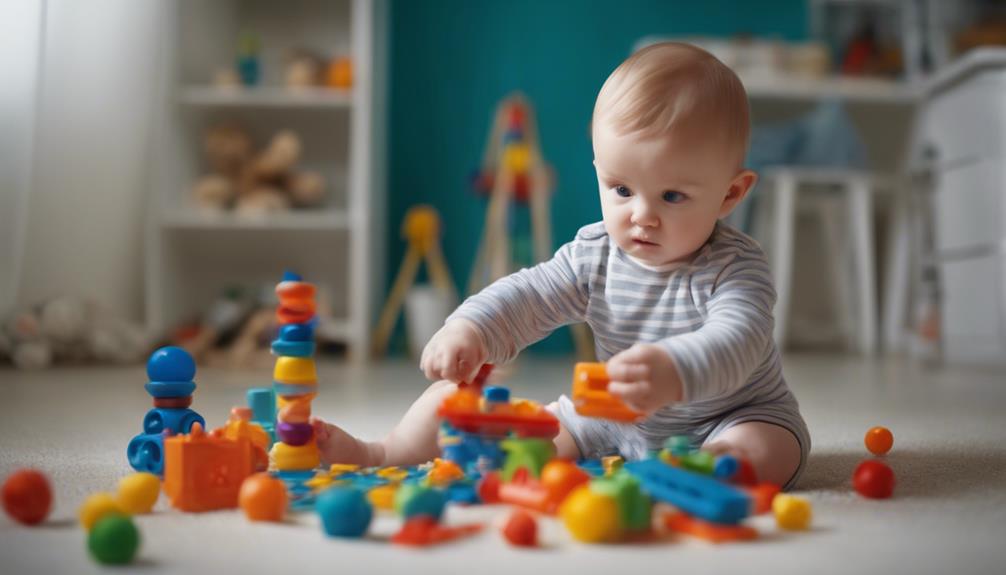You influence your baby’s learning by showing them how to interpret facial expressions, perform routines, and interact with objects. Your warm smiles, small gestures, and consistent actions help them understand emotions, develop social skills, and imitate your behaviors. Watching and mimicking you become key parts of their development. By paying attention to your cues, you guide their understanding of the world. Curious about how these little moments shape their growth? Keep exploring to learn more.
Key Takeaways
- Infants learn by observing facial expressions, which help interpret emotions and lay the foundation for emotional intelligence.
- Watching routine activities and responsibilities teaches infants about daily patterns and fosters a sense of security.
- Imitating object interactions demonstrates cause-and-effect and enhances fine motor skills.
- Reactions to actions, like smiles, reinforce social engagement and emotional understanding.
- Small gestures and non-verbal cues serve as powerful tools for early social and emotional learning.

Infants learn by watching the world around them, absorbing behaviors, language, and social cues from their caregivers and environment. During this essential period, your actions speak volumes, shaping how your baby understands and interacts with the world. One of the first ways your little one learns is through observing your facial expressions. When you smile warmly, your baby detects a sense of safety and happiness, encouraging them to mimic your joyful expressions. Conversely, if you show concern or surprise, your infant notices the change in your face, helping them interpret different emotions. These subtle cues are fundamental as they lay the foundation for your baby’s emotional intelligence and social skills. Regularly engaging in appliance maintenance plans can also teach your baby about routines and responsibility through your actions. Object interaction is another key aspect of their learning process. When you hand your baby a toy or pick up an object and demonstrate how to use it, your infant observes closely. They watch how you grasp, manipulate, and explore objects, often trying to imitate your actions. For example, if you demonstrate how to press buttons on a toy or turn pages in a book, your baby is absorbing that behavior, gradually understanding cause and effect. This observation not only encourages fine motor development but also helps your infant understand object permanence and the purpose behind everyday objects. Your repeated interactions with objects serve as live demonstrations for your baby, allowing them to learn through visual observation and mimicry. As your baby watches your facial expressions and object interactions, they begin to connect your actions with emotions and outcomes. They notice that a smile from you often results in positive responses, reinforcing social engagement. When they see you pick up a rattle and shake it, they learn about sounds and motion, which sparks curiosity and exploration. Your consistent demonstrations provide a blueprint for your infant’s developing skills, guiding them to imitate behaviors that foster independence and understanding. Remember, even the smallest gestures—like a reassuring nod or a playful peekaboo—are powerful learning tools.
Frequently Asked Questions
How Early Can Infants Start Learning by Watching?
You might wonder when infants start learning by watching. As their visual development progresses, they can begin focusing and paying attention to faces and objects by around 2 months. During this time, their attentional skills improve, allowing them to observe and process what they see more effectively. By about 3 to 4 months, babies become more attentive, actively observing your actions and facial expressions, which helps them learn and develop vital social and cognitive skills.
Do Infants Learn Better From Certain Types of Visual Stimuli?
You might wonder if infants learn better from certain visual stimuli. Bright colors, high contrast, and familiar faces tend to capture their attention longer, boosting their attention span. Simple, dynamic visuals help them focus and process information effectively. By providing engaging, age-appropriate visual stimulation, you support their learning and development, encouraging curiosity and better understanding through what they see.
Can Watching TV Negatively Impact Infants’ Learning?
Did you know that infants spend an average of 2 hours daily in front of screens? Watching TV can negatively impact your baby’s learning because passive viewing limits active engagement and interaction. Excessive screen time may hinder language development and social skills. To support your baby’s growth, it’s best to minimize screen time and encourage hands-on activities that promote learning through watching and doing.
How Does Parent Interaction Enhance Observational Learning?
You enhance your infant’s observational learning by actively engaging with them through model mimicry and caregiver cues. When you demonstrate behaviors, your baby mimics your actions, reinforcing learning. Using eye contact, facial expressions, and verbal cues, you guide their understanding and attention. This interaction creates a rich learning environment, helping your baby grasp new skills and concepts more effectively, fostering their development through your responsive and attentive involvement.
Are There Specific Activities That Boost Infants’ Learning Through Observation?
You can boost your infant’s learning through observation with activities like video modeling and imitation exercises. Watching videos designed for babies helps them see new words and actions, while imitation exercises encourage them to copy your gestures and sounds. These activities make learning engaging and effective, helping your little one develop important skills through simple, interactive methods that foster curiosity and understanding.
Conclusion
So, remember, every little thing you do is like a giant spotlight for your baby. Your actions are shaping their entire world—more than you could ever imagine! When you smile, they beam with happiness; when you fumble, they learn resilience. Your behavior isn’t just passing time, it’s building the foundation of their future. So, be mindful, because your every move could be the spark that ignites their lifelong journey of learning and growing.










